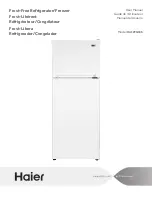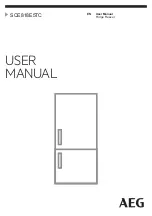
7
Do not stretch your hands into the bottom of the refrigerator, since you might be scratched by sharp metal corners.
Internal cleaning and external cleaning
The food residuals in the refrigerator are liable to produce bad odor, so the refrigerator must be cleaned regularly. The
fresh food compartment is usually cleaned once a month.
Remove all shelves, crisper box, bottle racks, cover board, and drawers etc., and clean them with a soft towel or sponge
dipped in warm water or neutral detergent.
Clear off the dusts accumulated on the rear panel and side plates of the refrigerator often.
After using detergent, be sure to rinse it with clean water, and then wipe it dry.
Do not use bristle brush, steel wire brush, detergent, soap powder, alkaline detergent, benzene, gasoline, acid, hot
water and other corrosive or soluble items to cleanse the cabinet surface, door gasket, plastic decorative parts, etc., so as
to avoid damage.
Carefully wipe dry the door gasket, clean the groove using a wooden chopstick wrapped with cotton string. After the
cleaning, fix the four corners of the door gasket first, and then embed it segment by segment into the door groove.
Interruption of power supply or failure of the refrigerating system
•
Take care of the frozen foods in the event of an extended non-running of the refrigerating appliance (such as interruption
of power supply or failure of the refrigerating system).
•
Try to open the refrigerator door as less as possible, in this way can food safely and freshly kept for hours even in hot
summer.
•
If you get the power outage notice in advance
:
1)
Adjust the thermostat knob to the high mode an hour in advance, so that foods get fully frozen (Do not store new
food during this time!). Restore the temperature mode to the original setting when power supply becomes normal in a
timely manner.
2)
You can also make ice with a watertight container, and put it in the upper part of the freezer, so as to extend the time
for fresh food to be stored.
Note: Once the refrigerator is used, you
’
d better use it continuously; and under normal circumstance, do not stop its
use, so as not to affect the service life.
Defrosting
This appliance is designed with automatic defrosting function, thus no need to defrost it manually.
Changing the lamp
The LED lamp is used by the refrigerator for lighting, which features low energy consumption and long service life. In case
of any abnormality, please contact the after-sales personnel for visiting service.
Safety-check after maintenance
Is the power cord broken or damaged?
Is the power plug firmly inserted into the socket?
Is the power plug abnormally overheat?
Note: Electric shock and fire accident may be caused in case the power cord and plug is damaged or stained by
dust. If any abnormality, please unplug the power plug and get in contact with the vendor.
How to dissemble the parts
Refrigerator shelf:
Hold the bottle rack with both hands, and then push it up.
Flip cover:
Keep the flip cover in the vertical direction, align its right side with the revolving shaft opening, and then pull out with force
to disassemble the flip cover.
Note: It is forbidden to close the door when the flip cover is opened, otherwise the refrigerator door may be
damaged.
VII.
Simple fault analysis and elimination
With regard to the following small faults, not every failure needs to be fixed by the technical service personnel; you can try
to solve the problem.
Case
Inspection
Solutions
•
Completely non-
refrigeration
•
Is power plug off?
•
Are breakers and fuses broken?
•
No electricity or line trip?
•
Re-plug
•
Opening the door and checking whether the
lamp is lit.
•
Abnormal noise
•
Is refrigerator stable?
•
Does refrigerator contact the wall?
•
Adjusting refrigerator's leveling feet.
•
Off the wall.
•
Poor
refrigerating
efficiency
•
Do you put hot food or too much food?
•
Do you open the door frequently?
•
Do you clip food bag to the door
gasket?
•
Direct sunlight or near a furnace or
stove?
•
Is it well-ventilated?
•
Temperature setting in too high?
•
Putting food into refrigerator when hot food
becomes cool.
•
Checking and closing the door.
•
Removing the refrigerator from the heat
source.
•
Emptying the distance to maintain good
ventilation.
。
•
Setting to the appropriate temperature.




























